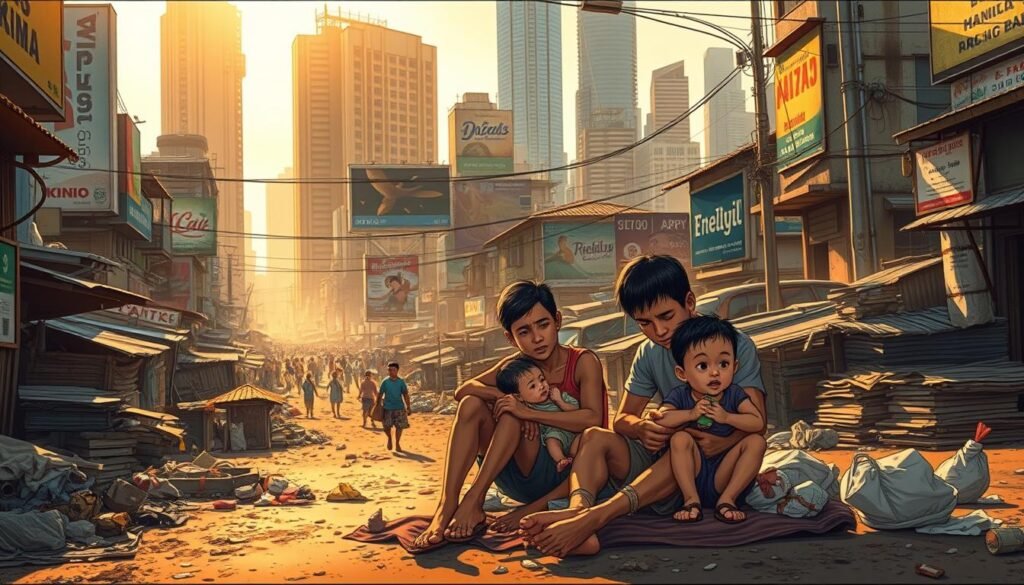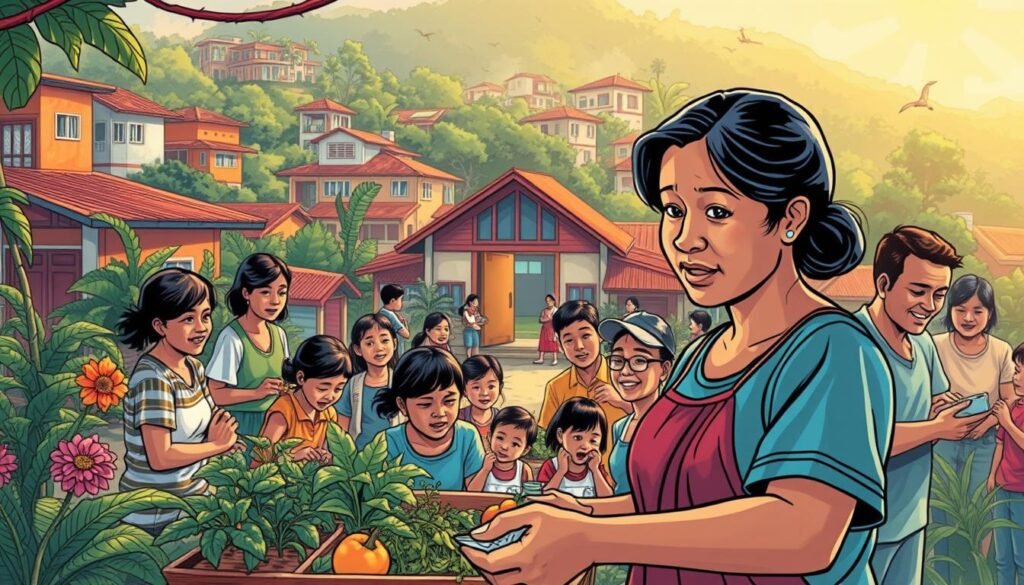Poverty and inequality remain pressing issues in the Philippines, affecting millions of lives. While progress has been made, with poverty rates falling from 49.2% in 1985 to 16.7% in 2018, the situation remains complex. The COVID-19 pandemic further exacerbated these problems, pushing the national poverty rate to 18.1% in 2021.
Life in the Philippines is shaped by a variety of factors, including genetics, environment, and cultural influences. These elements contribute to how individuals perceive and respond to challenges. Negative emotions often arise when facing hardships, but understanding the broader social implications is key to finding actionable solutions.
Mental health, time management, and a positive mindset play critical roles in addressing adversity. Every individual experiences challenges differently, making personalized solutions essential. By focusing on these aspects, we can work toward a way to improve the situation for everyone.
Key Takeaways
- Poverty in the Philippines has decreased but remains a significant issue.
- The COVID-19 pandemic worsened economic conditions in 2021.
- Genetics, environment, and culture shape how people face challenges.
- Mental health and a positive mindset are crucial in overcoming adversity.
- Personalized solutions are necessary due to varying experiences.
Understanding Poverty and Inequality in the Philippines
Understanding the depth of poverty and inequality in the Philippines is crucial for progress. Poverty is not just a lack of income but a complex issue that affects access to education, healthcare, and opportunities. For many Filipinos, this situation creates a cycle that is hard to break.

Inequality exacerbates these problems. The top 1% of earners capture 17% of national income, while the bottom 50% share only 14%. This disparity impacts community health, as those in poverty often lack access to basic medical care. Mental health concerns are also linked to these socio-economic disparities, creating additional barriers for individuals and families.
Defining Poverty and Its Social Implications
Poverty in the Philippines is defined as living below the poverty threshold of PHP79 per day per person. This issue affects over 17 million Filipinos, with rural areas like the Bangsamoro Autonomous Region experiencing the highest rates. Families in poverty often struggle to provide for their children, impacting their education and future opportunities.
The Role of Inequality in Community Health
Inequality creates unique challenges in accessing resources. For example, students from low-income families face learning loss due to limited access to technology during remote learning. This disparity affects their ability to compete in the job market later in life. Addressing these gaps requires targeted policies that focus on education, healthcare, and economic opportunities for everyone.
Factors Influencing Life’s Challenges in the Philippines
Life in the Philippines is shaped by a mix of genetic, environmental, and cultural factors. These elements create a complex situation that affects mental and physical health. Understanding these influences is key to finding effective solutions for everyone.

Genetic, Environmental, and Cultural Contributors
Genetics play a role in how individuals respond to stress and adversity. For example, some people may be more resilient due to inherited traits. Environmental factors, such as access to education and healthcare, also shape life experiences. In rural areas, limited resources often lead to greater struggles.
Cultural influences add another layer. Filipino families often prioritize collective well-being over individual needs. This can create pressure to succeed while supporting other family members. “The weight of responsibility can be overwhelming,” says a local community leader.
Impact on Students, Workers, and Families
Students face unique challenges, especially in low-income households. Many lack access to technology, making remote learning difficult. This affects their ability to compete in the job market later in life.
Workers often juggle multiple jobs to make ends meet. This leaves little time for rest or personal growth. Families, particularly in rural areas, struggle to provide for their children, impacting their education and future opportunities.
Community support and professional guidance can help manage these stressors. Programs like the Pantawid Pamilyang Pilipino Program (4Ps) have shown success in improving school enrollment and reducing dropout rates. Addressing these issues requires a lot of effort, but it’s essential for long-term progress.
Effective Strategies for Tackling Challenges
Addressing poverty and inequality requires actionable strategies that focus on planning, support, and resilience. These elements are essential for creating sustainable solutions that improve life for millions of Filipinos. By taking a proactive approach, individuals and communities can better navigate difficult situations.

Planning Ahead: Creating Actionable Solutions
Planning is a critical part of overcoming challenges. A detailed plan helps identify potential risks and reduces stress. For example, families can set financial goals to improve their situation over time. Programs like the Pantawid Pamilyang Pilipino Program (4Ps) have shown success by providing structured support to low-income households.
Breaking down larger issues into smaller, manageable steps makes them less overwhelming. This approach allows individuals to focus on one task at a time, building momentum toward long-term goals. “Small steps lead to big changes,” says a local community leader.
Utilizing Community and Professional Support
Community networks and professional guidance play a vital role in addressing challenges. Support systems provide resources, advice, and encouragement. For instance, local organizations often offer workshops on financial literacy and health management.
Seeking help is not a sign of weakness but a step toward empowerment. Collaboration fosters idea sharing and innovation, making it easier to find effective solutions. Effective strategies often involve leveraging collective knowledge and skills.
Building a Positive Mindset and Resilience
A positive mindset is key to overcoming adversity. Practicing gratitude and focusing on strengths can shift perspectives. This approach helps individuals see challenges as opportunities for growth rather than obstacles.
Resilience is built through consistent effort and self-reflection. By learning from past experiences, people can develop better ways to handle future challenges. Overcoming challenges becomes easier when individuals believe in their ability to succeed.
Even a lot of progress starts with small, consistent actions. By combining planning, support, and a positive mindset, Filipinos can create meaningful change in their lives and communities.
Implementing Practical Solutions for Health and Time Management
Effective health and time management are essential for navigating daily pressures in the Philippines. With the demands of work, study, and personal responsibilities, finding a balance can feel overwhelming. However, practical strategies can help individuals manage their time better and reduce emotional stress.

Overcoming Emotional and Time-Related Pressures
Emotional stress often stems from juggling multiple responsibilities. One way to manage this is by breaking tasks into smaller, manageable steps. For example, setting daily goals can reduce the feeling of being overwhelmed. “Focusing on one task at a time increases productivity by up to 500%,” according to recent studies.
Another effective technique is scheduling breaks. Research shows that taking a pause after 90 minutes of intense work helps maintain focus and energy. This approach not only improves productivity but also supports mental health.
Balancing Work, Study, and Personal Life
Balancing work, study, and personal life requires structured planning. Tools like digital calendars and task management apps can help individuals prioritize their responsibilities. For students, allocating 1-1.5 times the estimated time for tasks can counter the planning fallacy.
Delegating tasks is another practical solution. Whether at work or home, sharing responsibilities can free up time for more critical activities. Effective time management practices, such as time blocking, have been used successfully by professionals to maintain a harmonious balance.
Creating a personal routine ensures consistent progress even under high pressure. For instance, setting aside specific times for emails or study sessions can prevent distractions. Managing time effectively not only boosts productivity but also enhances overall well-being.
By implementing these strategies, individuals can create a more balanced and fulfilling life. Every small step contributes to long-term success and improved mental and physical health.
Conclusion
Addressing the multifaceted issue of poverty and inequality in the Philippines requires a combination of resilience, planning, and community support. Throughout this article, we’ve explored how factors like genetics, environment, and culture shape the challenges faced by Filipinos. From managing time effectively to prioritizing health, the strategies discussed offer a practical way forward.
Maintaining a positive mindset is a crucial part of overcoming these obstacles. By acknowledging the pressure and seeking support, individuals can take meaningful steps toward change. Programs like the Pantawid Pamilyang Pilipino Program (4Ps) demonstrate how structured solutions can make a difference.
As we conclude, remember that even small actions can lead to significant progress. Start by implementing one idea from this article in your daily life. Together, we can create a brighter future for the Philippines. For more insights, explore local knowledge management systems and their role in sustainable development.
FAQ
What are the main social implications of poverty in the Philippines?
Poverty in the Philippines affects access to education, healthcare, and basic needs. It often leads to limited opportunities for growth, creating a cycle that impacts families and communities.
How does inequality influence community health?
Inequality can lead to unequal access to healthcare services, nutrition, and sanitation. This disparity often results in poorer health outcomes for marginalized groups.
What factors contribute to life’s challenges in the Philippines?
Challenges stem from a mix of genetic, environmental, and cultural factors. Issues like limited resources, societal pressures, and economic instability play a significant role.
How can students and workers manage their time effectively?
Prioritizing tasks, setting realistic goals, and using tools like planners or apps can help. Balancing responsibilities requires focus and consistent effort.
What strategies can help build resilience in tough situations?
Developing a positive mindset, seeking support from loved ones, and focusing on small, achievable steps can strengthen resilience during difficult times.
How can communities address health and time management issues?
Communities can organize workshops, provide resources, and encourage collaboration. Sharing knowledge and tools helps individuals manage their health and time better.
What role does professional support play in overcoming challenges?
Professional support offers guidance, expertise, and structured solutions. It can be a crucial part of addressing complex issues like health, education, and work-related stress.
Source Links
- PHILIPPINES: Reducing Inequality Key to Becoming a Middle-Class Society Free of Poverty
- Overcoming Poverty and Inequality in the Philippines: Past, Present, and Prospects for the Future
- KEY FINDINGS Overcoming Poverty and Inequality in the Philippines: Past, Present, and Prospects for the Future
- Poverty in the Philippines
- PIDS urges targeted policies, resilience building to address poverty
- Educational Challenges in the Philippines
- Developmental Challenges and Mental Health in the Philippines – Richest Philippines
- Poverty-Philippines-Causes-Constraints-Opportunities.pdf
- 6 Proven Strategies To Tackle Challenges Now
- Strategies for Overcoming Workplace Challenges – BetterYou
- Overcoming Challenges: A Student’s Guide to Success
- Time Management: 10 Strategies for Better Time Management
- 9 Most Common Time Management Problems & Solutions: Definitive List
- 10 Time Management Skills and Techniques for Students
- Conclusion: The Challenges and Opportunities for Social Media Research (Chapter 13) – Social Media and Democracy
- 7. SUMMARY OF ISSUES AND CONCLUSIONS

